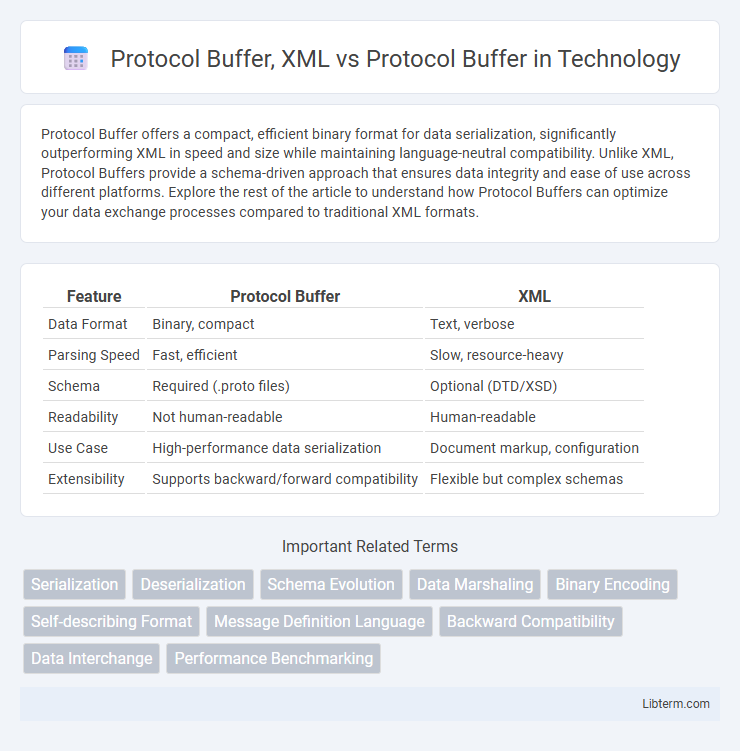Protocol Buffer offers a compact, efficient binary format for data serialization, significantly outperforming XML in speed and size while maintaining language-neutral compatibility. Unlike XML, Protocol Buffers provide a schema-driven approach that ensures data integrity and ease of use across different platforms. Explore the rest of the article to understand how Protocol Buffers can optimize your data exchange processes compared to traditional XML formats.
Table of Comparison
| Feature | Protocol Buffer | XML |
|---|---|---|
| Data Format | Binary, compact | Text, verbose |
| Parsing Speed | Fast, efficient | Slow, resource-heavy |
| Schema | Required (.proto files) | Optional (DTD/XSD) |
| Readability | Not human-readable | Human-readable |
| Use Case | High-performance data serialization | Document markup, configuration |
| Extensibility | Supports backward/forward compatibility | Flexible but complex schemas |
Introduction to Protocol Buffers
Protocol Buffers, developed by Google, provide a compact, efficient, and language-neutral mechanism for serializing structured data compared to XML's verbose and text-based format. Unlike XML, Protocol Buffers use a binary format that significantly reduces message size and parsing time, making them ideal for performance-critical applications and network communication. Their schema-driven approach enables strongly typed data serialization with backward and forward compatibility, enhancing robustness in data interchange.
Understanding XML Data Serialization
Protocol Buffer offers a compact, efficient binary serialization format, reducing message size significantly compared to XML's verbose, text-based structure. XML serialization prioritizes human readability and platform independence, using tags that increase payload size and parsing complexity. Protocol Buffer's schema-driven design enables faster serialization and deserialization, making it ideal for performance-critical applications requiring low-latency data exchange.
Core Features of Protocol Buffers
Protocol Buffers offer lightweight, efficient serialization compared to XML, using a compact binary format that reduces message size and speeds up parsing. Their schema-based structure ensures strict data validation and backward compatibility, enabling seamless evolution of data formats without breaking existing services. Protocol Buffers support multiple programming languages and generate code for serialization and deserialization, enhancing performance and interoperability across diverse systems.
XML Structure and Syntax Overview
Protocol Buffer uses a compact binary format with a schema defined in .proto files, which makes it more efficient for serialization compared to XML's verbose text-based structure that relies on nested tags and attributes. XML syntax requires explicit opening and closing tags, creating a hierarchical tree structure, while Protocol Buffer encodes data in a streamlined format optimized for performance and smaller size. The rigid schema and simpler syntax of Protocol Buffer enable faster parsing and reduced bandwidth usage versus XML's flexible but more resource-intensive markup language.
Data Serialization: Protocol Buffers vs XML
Protocol Buffers offer a compact, binary serialization format that significantly reduces data size and improves parsing speed compared to XML's verbose, text-based format. XML uses human-readable markup, which is flexible but results in larger files and slower processing times, making it less efficient for high-performance applications. Protocol Buffers, designed for efficient serialization and deserialization, enable faster data transmission and lower memory usage, ideal for scalable network communication and storage.
Performance Comparison: Speed and Efficiency
Protocol Buffer offers significantly faster serialization and deserialization speeds compared to XML, resulting in reduced processing time for data exchange. The compact binary format of Protocol Buffer requires less bandwidth and storage space, enhancing transmission efficiency over XML's verbose text-based structure. This performance advantage makes Protocol Buffer ideal for high-throughput applications and resource-constrained environments where speed and efficiency are critical.
Scalability and Flexibility Analysis
Protocol Buffer offers superior scalability over XML by providing compact binary serialization, resulting in faster data processing and reduced bandwidth usage essential for large-scale distributed systems. Unlike XML's verbose text format, Protocol Buffer's schema-based design allows flexible evolution of data structures without breaking compatibility, enabling seamless integration across diverse platforms. The lightweight and efficient nature of Protocol Buffers supports dynamic scaling needs and high-throughput environments, whereas XML's extensive markup and parsing overhead can hinder performance and flexibility in complex applications.
Human Readability and Ease of Use
Protocol Buffer offers a compact binary format that excels in efficient serialization and deserialization but lacks native human readability compared to XML's plain text structure. XML's verbose tags and nested elements enhance human readability and ease of manual editing, making it suitable for configuration files or data interchange requiring clarity. Protocol Buffer requires predefined schemas and tooling, which can complicate initial setup but streamlines data transmission, whereas XML is easier for humans to understand without specialized tools.
Use Cases: When to Choose Protocol Buffers or XML
Protocol Buffers excel in scenarios requiring efficient serialization, compact data representation, and high-performance communication, such as microservices, IoT devices, and real-time data streams. XML is preferred for complex document structures, interoperability with legacy systems, and human-readable data exchange in web services, configuration files, and data sharing across diverse platforms. Choose Protocol Buffers for speed and smaller payloads, while XML suits cases needing rich metadata, schema validation, and extensibility.
Conclusion: Selecting the Right Serialization Format
Protocol Buffer offers faster serialization speeds, smaller message sizes, and strong schema enforcement compared to XML, making it ideal for performance-critical applications and efficient data exchange. XML provides human-readable formatting and extensive support for complex document structures, which benefits interoperability and ease of debugging but at the cost of larger payloads and slower parsing. Choosing between Protocol Buffer and XML depends on priorities such as speed, compactness, schema validation, and readability requirements in the target system.
Protocol Buffer, XML Infographic

 libterm.com
libterm.com